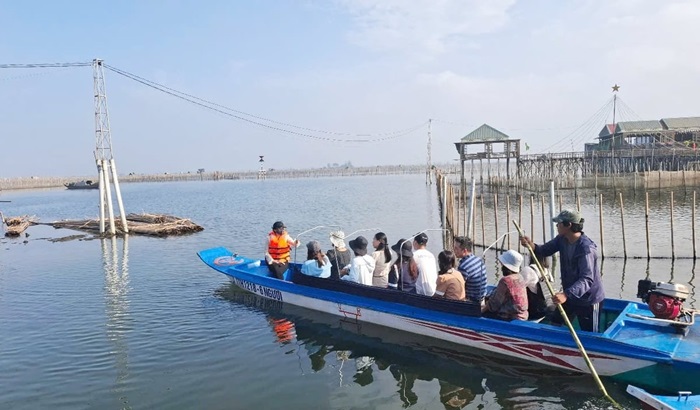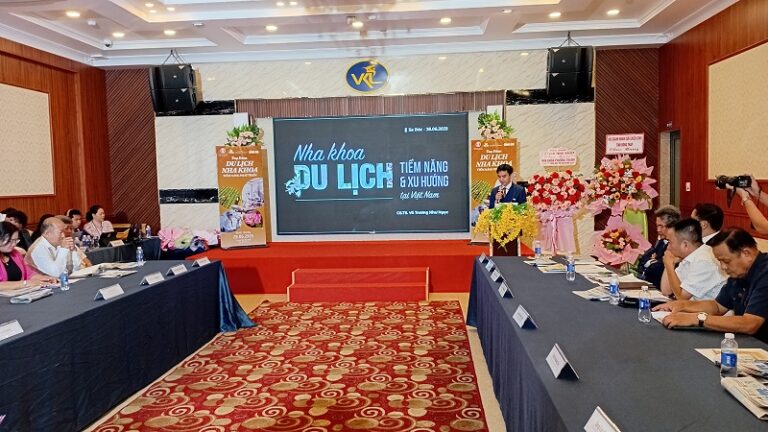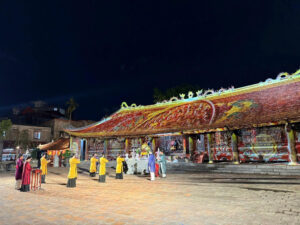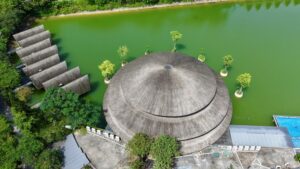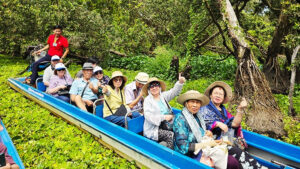In 2015, Dang Tien, a critic, wrote me that he had just found a painting of the Perfume river by Bauchaud, a French artist, in 1902. The beautiful painting vividly depicted women from the market waiting to get on the boat by the Perfume river. The painting later appeared on the cover of the special issue of the Song Huong Magazine (Perfume River Magazine) in March 2015.
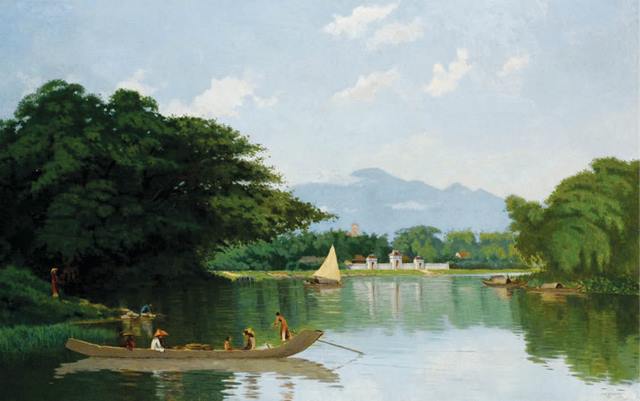
“The Perfume River in Hue” by Charles Ulmann in 1907
But Bauchaud’s is not the earliest painting about the Perfume river by French artists.
The French artist considered to arrive and painted in Hue the earliest was Gaston Roullet (1847-1925). In late 1885-early 1886, Gaston Roullet arrived in Vietnam and did 203 paintings and sketches. He visited Hue during the New Year’s Holidays and completed many paintings about Hue, including some about the Perfume river.
At the moment, Hue lovers can have access to his two paintings about the Perfume river. The painting "Dong Ba River in Hue Citadel" has long been familiar to many people. But few people know that he painted another painting of the Dong Ba river with the Dong Ba wooden bridge and the Dong Ba gate in the distance. Those paintings help us figure out the boats on the Dong Ba river in the past and the daily life of boatmen in Hue at the time.
In 1907, Charles Ulmann came to Hue and painted "The Perfume River in Hue” portraying the peaceful Perfume river with luxuriant trees mirroring themselves in the water. Above was the blue sky with white clouds and in the distance were mountain ranges. Next to the river lay the triple gate of a phu (residence of a prince,) and behind the bamboo hedge located a protruding tower.
Looking at this painting, one can visualize the boats on the Perfume river in the old days. Though more than 100 years have passed, the boats are unchanged. But boatmen and clients are different. Hue people at the time always wore ao dai (traditional costume for both men and women in Vietnam.) One interesting thing is that there used to be sailboats on the Perfume river.
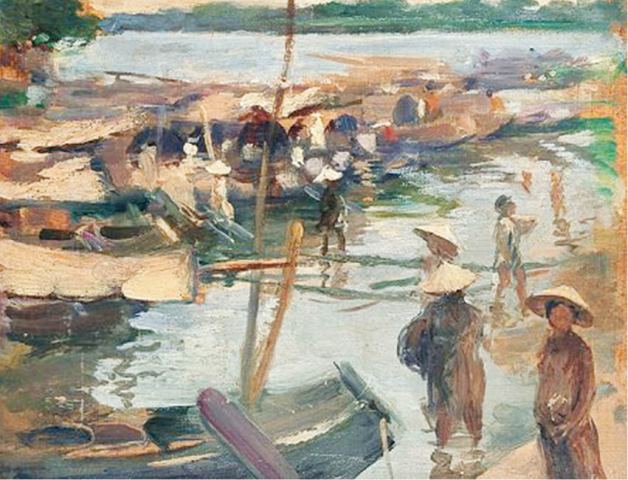
“Market by the River” by Victor Tardieu
In February 1921, Victor Tardieu went to Vietnam. Thanks to his extensive relationships with high-ranking figures, he was successful in convincing Merlin, the Governor General of Indochina, to issue a decree on October 27, 1924 to found the Indochina Fine Arts College. He himself was the first principal of the school.
Also in 1924, he came to Hue and left for posterity the oil painting "Market by the River,” which was painted with coarse but liberal brush strokes with vivid images. The painting depicted sampans on the Dong Ba river connected with the Perfume River and women carrying their baskets.
In 1886 Gaston Roullet gave a striking exhibition of his over 200 paintings and sketches about Annam and the Indochina. After that, he participated in the 1889 World Exhibition with his 24 oil paintings on display in the booth named “Annam and Tonkin”.
Gaston Roullet’s paintings exerted a big influence on many great contemporary French artists. Interestingly, inspired by Gaston Roullet’s paintings, Gauguin, the famous artist, made some pretty sketches based on the images in this exhibition.
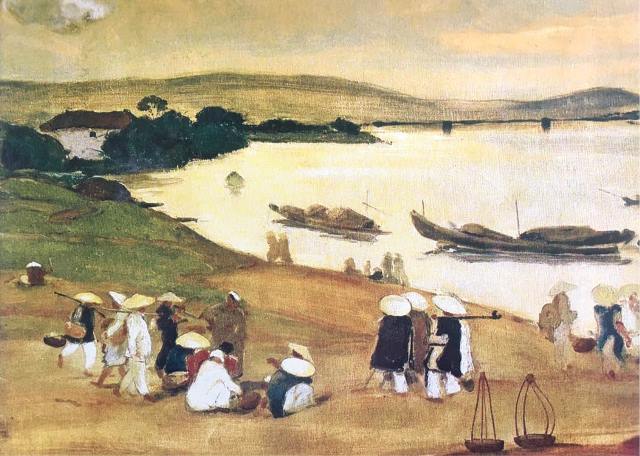
“The Perfume River 1902” by Bouchaud
The captivating images of Hue as a pristine Eden made Gauguin want to escape from Paris, known as the kingdom of light, which he considered exhausted and corrupted by the industrial civilization. He then wrote to the Ministry of Colonies about his desire of traveling to Vietnam to look for new inspiration for art creation.
However, Gauguin's application was rejected because his ideals were inconsistent with the colonial principles and policies. Hue, Vietnam, and the Indochina unfortunately missed the opportunity to welcome a great talented artist.
Until now, the Perfume river has been the inspiration for French painters. On March 9, 2009, at the headquarters of the Vietnamese Association in Paris, Gérald Gorridge, lecturer at Angouleme Visual Arts University launched the collection of "Perfume River Paintings.”
According to Gérald Gorridge, he first came to Hue in 1992. At that time, there were very few tourists, so he was able to feel its wild appearance. He met many friendly Vietnamese people. He was so impressed that he decided to involve himself with Vietnam. He wanted to do good things for the country with peace-loving people.
Gérald Gorridge sponsored and coordinated the cooperation program "Vietnamese Folk Painting and Comics,” starting from April 2001. With this project, Gérald Gorridge had the opportunity to work with young Vietnamese painters. He returned to Hue at least 17 times.
“And every time I come back, Hue as well as Vietnam always gives me new inspiration for creativity. Especially the Perfume River is so charming beyond description,” said he.
The picture book “Paintings of the Perfume river” is the result of more than four months of hard work by the artist. With more than 80 paintings portraying Hue, Gérald Gorridge brings viewers along the famous river to explore all aspects of the former imperial capital: mossy relics, old trees which have witnessed the changes of the land, the shimmering Truong Tien bridge at night, the endless rains, the family together on a cozy boat. They are all depicted through Gérald Gorridge's colors and typical brush strokes, evoking many feelings and emotions.
For many artists, the Perfume river is an endless inspiration.
Story and photos: Ho Dang Thanh Ngoc


